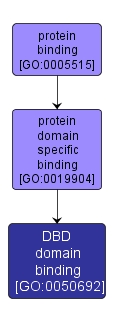| Desc: |
Interacting selectively and non-covalently with the DBD, DNA binding domain, of a protein. The DNA binding domain of the vitamin D receptor, one of a family of receptors with the DBD, is split into three regions, the P, D and T boxes. Residues that are critical for target sequence selectivity form the P-box. The D-box contains residues that are important for homodimerization of class I nuclear receptors. The T-box is essential for both DNA-binding and transactivation of the VDR; this region may also be important for dimerization with RXR for class II nuclear receptors. |














